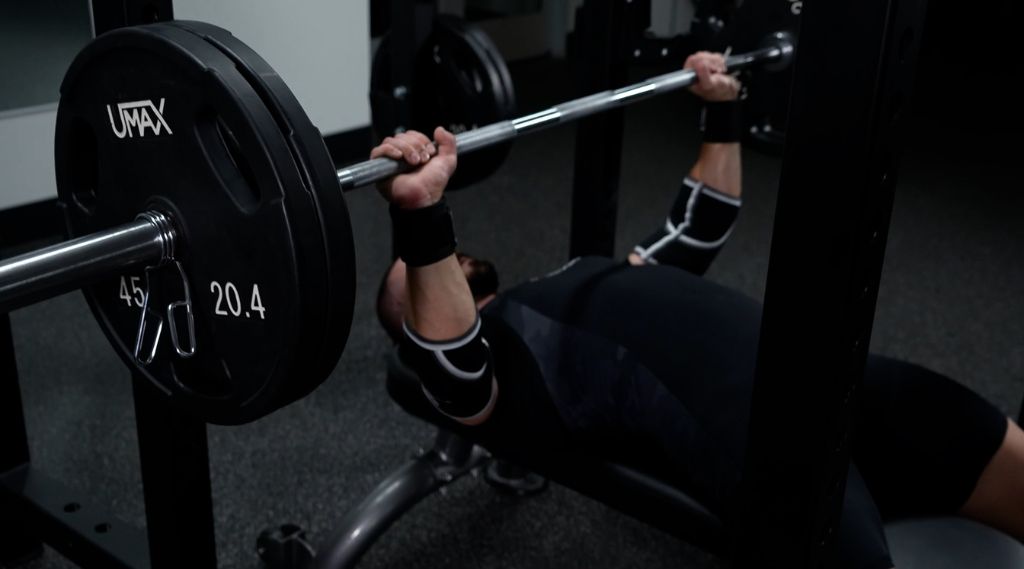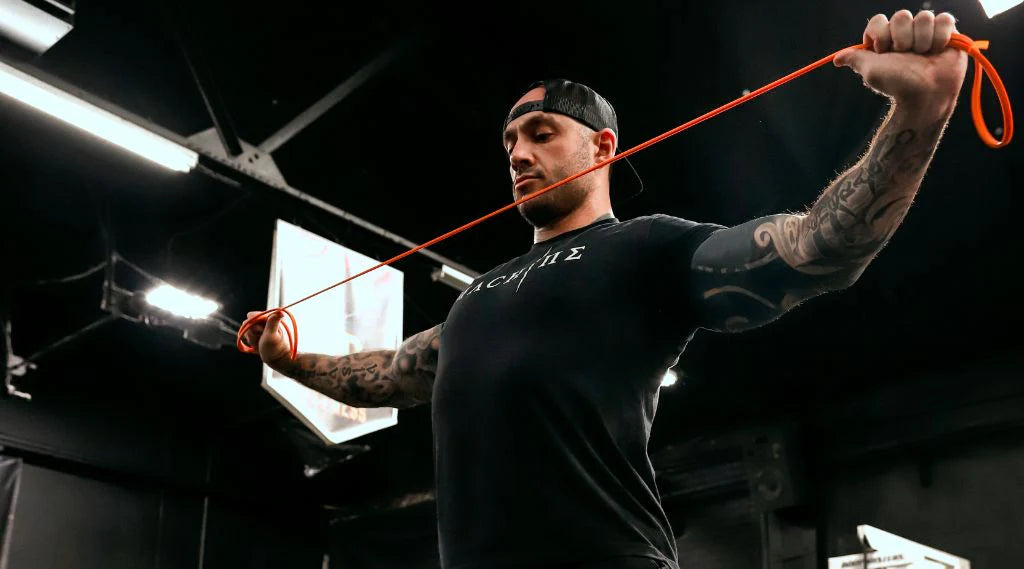Banded bench presses might be on your radar if you’re trying to bust through sticking points caused by a weak lockout, or you’re trying to grow an Arnold-esque chest.
Whatever the reason, you’re likely wondering if this exercise is worth incorporating, how to set it up, and how to perform it correctly.
Banded bench press is a great exercise to help build your lockout strength. You can use a band by itself to warm up for heavier loads or to add in some extra volume. Alternatively, you can use bands to augment your barbell or dumbbell pressing and work through weak points.
Below, I will discuss in-depth the benefits of a banded bench press, analyze the different variations of the movement, and teach you how to properly set up the bands to avoid common mistakes.
Key Takeaways
What Is A Banded Bench Press?
A banded bench press involves taking your regular bench press movement and adding a resistance band. It is a great movement that primarily targets your chest muscles, but will also indirectly target your shoulders and triceps, depending on what variation of the movement you do.
This exercise can be done with the band alone, or by using the band to provide additional stimulus and weight to a barbell or dumbbell bench press.
When completing a barbell or dumbbell banded bench press, note that the added band tension means that the weight will get heavier as you get closer to the top of the movement, and the movement will be easier the closer you get to your chest.
This information can be helpful when you are choosing the resistance of your band since most bands come in a variety of weight resistances (more on what bands to get later).
Banded Bench Press Muscles
The major muscles worked in a bench press are the pecs, but other muscle groups like your shoulders and triceps are also involved. More specifically, the muscles used in a banded bench press are:
Related Articles:
- Banded Deadlifts: Benefits, How-to, Common Mistakes
- Bent Over Rows With Bands (The Proper Way)
- Cable Crossover With Bands: How to Do It
- Banded Squats: Benefits, How-to, Common Mistakes
Benefits Of Banded Bench Press

The benefits of training your bench press with bands include:
Stronger Lockouts
This is the biggest benefit of banded bench presses. The resistance increases as the band stretches, so the more you practice pressing with a band, the stronger you will be in the lockout portion of the press.
This is my favorite benefit of the banded bench press for myself and as a coach. I am very strong pressing off of my chest, and my sticking point is almost always the lockout once the movement becomes more tricep dominant. Banded bench is a great way to overload the movement and train that weak point.
Increased Intensity/Burnout Sets
Incorporating banded presses has great hypertrophy benefits by helping you introduce a new stimulus for your body to adapt to. You can do a free-weight bench press set, pick up a band, lie back down, and then grind out some more reps with just band tension until failure.
Great Warmup
Banded movements in general are great for warming up your joints. Banded bench presses can increase blood flow and prepare your muscles and joints for heavier pressing movements.
Constant Tension
Bands provide constant tension to your muscles throughout the entire movement, which can result in better muscle activation that leads to greater gains in strength and hypertrophy.
Challenges Your Stability
Banded movements are more unstable, which will force you to engage your core, back, and other upper body stabilizers more to maintain the proper technique. This can help you become more resistant to injury over time.
Potential To Lift Heavier Loads (reverse banded)
If you want to strengthen the bottom portion of your bench press (off your chest) while making the lockout easier, you can implement reverse banded bench presses. This is done by securing the bands to a sturdy bar above you.
How To Perform Banded Bench Presses Correctly
To perform banded overhead presses correctly, you’ll need proper equipment and to decide which variation of the movement best suits your needs.
1) Bands
As you probably guessed, you will need a band. I highly recommend purchasing multiple bands so that you have different levels of resistance to choose from as you get stronger and to use for different variations of the movement.

The Gymreapers Military Resistance Band Set is a great full set of resistance bands. The set comes with bands that range in resistance from 20-150 lbs to satisfy every need possible for adding banded training exercises into your program.
If you do not want a full resistance band set, you can buy the bands individually. The Gymreapers Resistance Band will likely be the most helpful.
2) Joint Support
Additional supportive equipment that could be helpful for bench pressing, especially if you’re using bands in combination with a barbell or dumbbells to increase resistance are:

- Gymreapers 10MM Lever Belt: lifting belts are incredibly helpful for increasing intra-abdominal pressure, maintaining core stability and rigidity, and generating more force production. All of these benefits are directly helpful when you are doing challenging sets of presses.

- Gymreapers Wrist Wraps - 18” Weightlifting Wrist Support: the weak link of every pressing movement is most commonly a lifter’s wrists. Gymreapers wrist wraps provide excellent support and stability to the wrist joint to ensure that you are lifting the maximum amount of weight as safely as possible.
Banded Bench Press Variations
Banded bench presses can be done in multiple variations, but the most common 3 are:
Variation #1: Resistance Band Alone
This variation requires the least amount of equipment, requiring only the use of a band and a bench.
This is a great exercise for those just getting into resistance training, for those rehabilitating an injury, or a great warm-up for more experienced lifters who are aiming to do a heavier pressing movement later in their workout.
When people are doing a resistance band bench press with just the band alone, they most commonly anchor the band underneath their bench.
Once the band is secured underneath the bench, you will grab one end of the band in each hand and simply press up and down in the traditional bench press movement.
Banded movements alone tend to be easier than barbell or dumbbell variations and usually require 15-30 reps to achieve a hypertrophy effect.
Pro tip: I recommend looping the band over your thumbs and having it cross your palms. This will feel the most secure, will not put awkward pressure on your wrists, and will give you a nice squeeze at the top of the rep.
Variation #2: Barbell Banded Bench Press
A second variation for banded bench presses is the barbell banded bench press.
This exercise is a great way to improve your lockout and increase the involvement of your triceps when you are bench pressing.
To set this exercise up, you would first set your barbell as normal and find a sturdy place to secure the bands directly below the barbell.
Bands are most commonly anchored to the bottom of your rack, anything bolted to the ground, your bench itself, or a very heavy dumbbell.
Once your bands are secured, perform the bench press like normal. Remember that due to the increasing band tension, this movement will feel easier when the bar is near your chest and will be harder the closer you get to the lockout.
Variation #3: Dumbbell Banded Bench Press
A final common variation of the banded bench press is very similar to the barbell variation mentioned above but instead uses dumbbells.
When performing this movement, it is easiest to wrap the band around your back and secure it in your palms as if you were doing Variation #1.
Next, simply grab the dumbbells as you normally would and lie down. Aim to place the band close to the center of your hands, looped around your thumb, so you can press evenly whilst still keeping your grip on the dumbbells.
This exercise is more awkward to do than the barbell variation because of the way the bands wrap around your arms, but it can still be a great exercise to augment your training.
4 Banded Bench Press Mistakes (And How To Fix Them)
Now that you know how to perform each variation properly, it’s important to address some common mistakes and how to fix them.
Mistake #1: Not Using Enough Weight
One of the major mistakes I see when people are doing banded bench presses is that they are not using enough resistance, or they are not doing enough reps.
If you are only using the band for resistance (variation #1), the minimum number of reps you should be doing is 15. Don’t be afraid to go over 20-30 reps because growth will only occur if you’re getting close to failure.
Additionally, I notice that plenty of people are misjudging the weight (resistance level) of the band and failing to challenge themselves. You shouldn’t be using the same level of resistance over and over again without any sort of progression.
Fix: Use Appropriate Loads & Increase Them Over Time
The easiest fix for not using enough weight is to simply increase the amount of weight that you’re using by choosing a heavier band.
For example, if you’re using a red band that adds 15-35 lbs of resistance and you can do well over 30 reps without fatiguing, then switch to a black or purple band that offers more resistance.
One strategy that I like to use for tracking my progression over time is to learn how much resistance the band is providing based on how far it is stretched while I’m pressing.
The easiest way to do this, as shown in this video, is with a fishing scale.
Once you know the actual band tension you are adding to your lift, you can accurately track it and progressively increase it in your training, which leads to better long-term gains.
At the very least, make an effort to continue pushing yourself over time to give your body a reason to adapt.
Mistake #2: Putting The Band On the Sharp Knurling
A second major issue I see, primarily in powerlifting gyms, is placing the band directly onto a barbell with a very sharp knurling when performing a Barbell Banded Bench Press (Variation #2).
Placing the band on sharp knurling will dramatically reduce the lifespan of the band, as all the little knurling teeth on the barbell will be sawing through the band with every repetition.
Fix: Use a Barrier In Between the Band and the Bar
I like to solve this problem by placing something on the bar that the band will rest on.
The 3 things I use as barriers between the band and the bar are Fat Grips, towels, or squat pads used for squats or hip thrusts.
Alternatively, you could attach the band to the sleeves of the barbell (where the weight plates go) which is smooth, rather than the shaft of the barbell (where you grip) which has knurling.
Mistake #3: Incorrect Bar Path
Regardless of whether you are doing a barbell or dumbbell banded bench press, you will want the weight to move with a similar bar path.
Ideally, you will be touching the weight on your chest somewhere above your ribs and below your shoulders.
You will likely have the weight in your hands just outside of your shoulders (this may vary based upon your goals), your wrists should be relatively straight with vertical forearms, and your elbows should be directly underneath the bar when you are in the bottom position.
As you press, the weight should come off your chest and drift back slightly toward your face. This should result in the bar or dumbbells ending up directly stacked over top of your shoulders at the top of the position.
This is the best technique, but I often see people struggling to keep this bar path consistent once they add a band to the equation.
It’s common to see lifters get very shaky and begin pressing too far forward, too far backward, or a combination of the two as they try to keep the bar or dumbbell stable against band tension.
Fix: Anchor the Band Directly Beneath Where You Will Be Pressing
Although bands do require more stability and core engagement, this problem can still be mitigated by properly anchoring the band directly underneath where you are pressing.
Do not anchor the band directly underneath the bar when it is in the rack.
Instead, tie the band in a location that will be approximately directly underneath the bar (or dumbbell) when you are performing the exercise.
This will ensure the tension is only being applied to the bar (or dumbbell) in a vertical plane, and you will not have to fight against unwanted horizontal forces.
Mistake #4: Not Using Full Range of Motion
The main reason you may be performing a banded bench press is to train your lockout strength and get past sticking points, so it becomes a problem when you’re not fully locking out your presses.
If you’re failing to lock out because the tension the band is providing is too great, then you are not allowing the band to work its magic. You must fully lock out your arms to develop strength in that range of motion.
Fix: Reduce Band Tension To Lock Out Every Rep
If locking out your arms just isn’t possible because the tension at the top of the rep is too much for your muscles to overcome, then reduce the band tension so that you can complete the full range of motion for each repetition.
How To Incorporate Banded Bench Press Into Your Workout Plan
The best way to incorporate banded bench presses will depend on your specific goals and training structure, but there are a few general guidelines to consider.
For band-only bench presses (variation #1)
I would integrate these into every single warmup for any pressing movement in your training program. To do this, pick a band that you can do 3-4 sets of 12-20 reps for a great warm-up.
For reference, I bench press over 400 pounds and will typically use the purple bands that give 30-85 lbs of resistance.
For banded barbell bench presses (variation #2)
I would implement this as my primary push movement for the day. I recommend doing this movement once a week for 4 sets of 8-12.
You are likely doing this movement to develop your regular bench press speed and lockout, so I recommend doing the banded version later in the week after you’ve done your primary bench day.
If you want to get extra volume in, strip the weight after your last set and do a burnout set of just the bands and the bar. This will definitely fatigue and grow your pecs and triceps.
For banded dumbbell bench presses(variation #3)
I would implement these as a secondary pressing movement (an accessory movement rather than your main pressing movement).
If you are pressing 2 times a week, I would place this movement on the same day as my primary bench, and not on the same day as my secondary bench movement. For example:
- Primary Bench Day
- Bench Press
- Banded DB Bench Press: 3-5 total sets of 10-15 reps per set
- Accessories
- Secondary Bench Day
- Banded Barbell Bench Press
- Accessories
When picking a load for a banded bench press, I recommend loading 50-65% of whatever you do for a normal bench press for the same sets and reps and then adding 50-65% of that load with band tension.
As a rough example, for someone that can bench press 200 lbs for 4 sets of 12, I would load somewhere around 125 lbs of free weight. I would then add another 100-130 lbs of band tension so that the overall load at the very top of the rep is 225 to 255 lbs.
Again, this is a rough example and you will have to change the numbers for yourself. Someone with a stronger lockout may do well with adding more band tension than someone weaker at the lockout.













Leave a comment
All comments are moderated before being published.
This site is protected by hCaptcha and the hCaptcha Privacy Policy and Terms of Service apply.